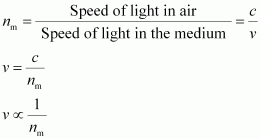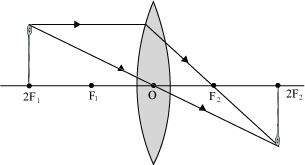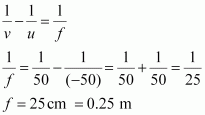NCERT Solution: Light Reflection and Refraction
Find out, from Table, the medium having highest optical density. Also find the medium with lowest optical density.
| Material medium | Refractive index | Material medium | Refractive index |
| Air | 1.0003 | Canada Balsam | 1.53 |
| Ice | 1.31 | ||
| Water | 1.33 | Rock salt | 1.54 |
| Alcohol | 1.36 | ||
| Kerosene | 1.44 | Carbon disulphide | 1.63 |
| Fused quartz | 1.46 | Dense flint glass | 1.65 |
| Turpentine oil | 1.47 | Ruby | 1.71 |
Highest optical density = Diamond
Lowest optical density = Air
Optical density of a medium is directly related with the refractive index of
that medium. A medium which has the highest refractive index will have the
highest optical density and vice-versa.
It can be observed from table 10.3 that diamond and air respectively have the
highest and lowest refractive index. Therefore, diamond has the highest optical
density and air has the lowest optical
density.
You are given kerosene, turpentine and water. In which of these does the light travel fastest? Use the information given in Table.
| Material medium | Refractive index | Material medium | Refractive index |
| Air | 1.0003 | Canada Balsam | 1.53 |
| Ice | 1.31 | ||
| Water | 1.33 | Rock salt | 1.54 |
| Alcohol | 1.36 | ||
| Kerosene | 1.44 | Carbon disulphide | 1.63 |
| Fused quartz | 1.46 | Dense flint glass | 1.65 |
| Turpentine oil | 1.47 | Ruby | 1.71 |
| Benzene | 1.50 | Sapphire | 1.77 |
Ans
Speed of light in a medium is given by the relation for refractive index
(nm). The relation is given as

It can be inferred from the relation that light will travel the slowest in the
material which has the highest refractive index and travel the fastest in the
material which has the lowest refractive index.
It can be observed from table 10.3 that the refractive indices of kerosene,
turpentine, and water are 1.44, 1.47, and 1.33 respectively. Therefore, light
travels the fastest in water.
The refractive index of diamond is 2.42. This means that the speed of light in diamond will reduce by a factor of 2.42 as compared to its speed in air.
In other words, the speed of light in diamond is 1/2.42 times the speed of light in vacuum.
Power of lens is defined as the reciprocal of its focal length. If Pis the power of a lens of focal length Fin metres, then
P= 1/f(metres)
The S.I. unit of power of a lens is Dioptre. It is denoted by D.
1 dioptre is defined as the power of a lens of focal length 1 metre.
∴1 D = 1 m - 1
When an object is placed at the centre of curvature, 2F1, of a convex lens,
its image is formed at the centre of curvature, 2F2, on the other side of the
lens. The image formed is inverted and of the same size as the object, as shown
in the given figure.

It is given that the image of the needle is formed at a distance of 50 cm from
the convex lens. Hence, the needle is placed in front of the lens at a distance
of
50 cm.
Object distance, u= - 50 cm
Image distance, v= 50 cm
Focal length = f
According to the lens formula,

Power of Lens P = 1/ f (metres)
= 1/ 2.5 =+4D
Hence, the power of the given lens is +4 D.
Focal length of concave lens, f = 2 m
Power of lens, P= 1/f = 1/(-2)= -0.5D
Which one of the following materials cannot be used to make a lens?
(a) Water
(b) Glass
(c) Plastic
(d) Clay
Ans (d) Clay
The image formed by a concave mirror is observed to be virtual, erect and larger than the object. Where should be the position of the object?
(a) Between the principal focus and the centre of curvature
(b) At the centre of curvature
(c) Beyond the centre of curvature
(d) Between the pole of the mirror and its principal focus.
ANS (d) Between the pole of the mirror and its principal focus.